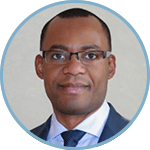 Jesse Manunga, MD, is a vascular surgeon at Abbott Northwestern Hospital in Minneapolis, Minnesota. Dr. Manunga shares his thoughts on getting experience with FEVAR as a new attending and building a team to support the procedure.
Jesse Manunga, MD, is a vascular surgeon at Abbott Northwestern Hospital in Minneapolis, Minnesota. Dr. Manunga shares his thoughts on getting experience with FEVAR as a new attending and building a team to support the procedure.
How did you start your FEVAR program when you first got into practice?
I had interest. I knew that I wanted to do endovascular and open complex aortic work. But my first emphasis was endovascular. I interviewed at a number of places and had several job offers, and I made sure everywhere I interviewed that they were supportive of my vision. I was coming out of fellowship a year after ZFEN was approved, and a lot of people were still doing back table stuff. In fellowship, we had participated in or had seen at least 50 fenestrated cases done. Most of us who came from Mayo knew what it entailed and wanted to continue this work. Decision to take the job in Minneapolis was based on the community need and the desire of the institution to start a fenestrated program.
How did you go about building your team when you got to Abbott Northwestern?
This can be a daunting task, because you are walking right into a mature practice. I was joining straight out of fellowship as the sixth or seventh surgeon in a group. These guys were very accomplished and as a young surgeon you come out and say, “Hey, I’m going to start doing this new procedure.” I think it starts by building trust. Building trust starts by doing easy things. I knew the volume was there. It started with me being on call and getting ruptured aneurysms, and being able to do them both open and endovascularly—open for those who didn’t have a neck or endovascular for those who had a neck, and patients survived them. We got really lucky where we got no mortality and no complications early in experience.
When I started, I made this presentation on fenestrated stent grafts, and gave it to my partners. I kept on showing them what’s possible and what other people are doing, and I kept on saying “A bigger healthcare system like this cannot survive without this program. We need it—our patients need it.”
From there, I went on to giving talks on the topic to nurses, anesthesia team and Cath Lab techs. I started to see people growing in interest saying “We need to do this.” And yet, I still did not have an ideal patient for this. It wasn’t until one of my partners actually referred a patient like, “Hey, this patient has a juxtarenal aneurysm, but he does not want an open repair. How about that fenestrated thing you were talking about?” The patient came and saw me in the clinic and I said, “We can do this.” And he said, “How many have you done?” And I said, “Zero here. But I trained at the Mayo Clinic and I saw a lot of these and I feel comfortable doing this.” And it so happened that we had two patients that needed fenestrated stent grafts on the very first day. I scheduled them on the very first day. I was eager to get a proctor in, and get these signed off. I was confident that I could do these cases. We finished the first case in ninety minutes I think, and the second case took us even less, I think forty-five minutes and we were done. We stented both cases. I had good support from the interventional radiologist who was my partner— Andy Craig—and he had very good wire and catheter techniques. He and my boss – Tim Sullivan – really helped support my vision and me. I knew that I had the support and that proved to be really helpful.
What is your team like now? How do you train your team?
To date, there is one assistant and me that work together on these cases all the time. If the other surgeons get a fenestrated case, I believe in training everyone, so everyone has to learn. Fenestrated stent grafting is not for everybody. There are some surgeons who say, “No, I don’t want to do that.” Our practice has so many young people who want to get involved in the program. If they want to do a case, it’s okay. They just need to have someone with experience there and I make myself available to them.
As far as the team, that was a challenge, it became very clear, very quickly that to produce the best results we needed to establish a dedicated team. We trained a core group of people and a lead tech who is with us on every single fenestrated case we’ve done. Then once the hospital noticed that we are serious, and we showed them our results and our results are good, we started asking them “Okay, we need fusion CT, and we need TerraRecon.” They didn’t have this stuff when I started. I had to go back and show them that I’m an investment to them.
It takes a team. I look at Gustavo Oderich and the way he does it. Number one, he has same team over and over again. But how he does it, I can never give him too much credit. It is so important to have the support of other physicians, to have the same team over and over again. Results don’t happen in a vacuum. They happen because you have a great team.
Get stories like these sent to your email.
Sign up for our quarterly email newsletter to receive physician stories, product news, training opportunities and more in your inbox.
Jesse Manunga, MD, is a paid consultant of Cook Medical.